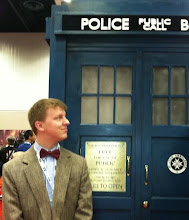We see the same thing in film, but it’s more rare. When an actor wins or is nominated for an Academy Award their performance becomes something very accomplished. Reprising the role creates a very high standard.

This weekend Michael Douglas returns to Wall Street (That should be the title of the film!) in Wall Street: Money Never Sleeps. In 1987, Douglas won for his dynamic performance of Gordon Gekko. 23 years later he returns to comment on the new state of capitalism and, of course, greed. Paul Newman did a similar thing when he was nominated for The Hustler and ended up taking home the statue for The Color of Money, 25 years later. This worked out for him—besides the Academy realizing they haven’t given him a statue yet—because it’s a great sequel. Fast Eddie had a lot of energy and ambition in the first movie but later on he’s tired and more cynical. It really is a great examination of the character in a new light.
This also works for further nominations of Al Pacino as Michael Corelone and Cate Blanchett as Queen Elizabeth. Most of the time, this is not the case. When there is a sequel, the movies don’t factor time and evolution into the character. Johnny Depp was nominated for his role as Captain Jack Sparrow for the first Pirates of the Caribbean film. I’m almost alone in still enjoying the sequels, but the movies aren’t designed to add new things to the character. It’s essentially the same entertaining performance.
This sort of thing has happened even back in the 40s. Bing Crosby won the Oscar for his role as Father Chuck O’Malley in the delightful film Going My Way. In the sequel, the character goes to a new church in the movie The Bells of St. Mary. He was nominated again (and so was Ingrid Bergman) even though it was the same performance but a different scenario. The same goes for William Powell playing Nick Charles in five addition Thin Man movies.

Those movies actually have good sequels. Sometimes there are diminishing returns. The Silence of the Lambs terrified audiences but how many people are big fans of Hannibal or Red Dragon. Anthony Hopkins deserved the Oscar for terrifying audiences the first time around, but each additional movie lost what was special about the original. In the first film, Hannibal Lector was more of a supporting player whose presence really stuck with audiences. The same goes for Tommy Lee Jones in his Best Supporting Actor winning performance in The Fugitive. Then he becomes in the lead in U.S. Marshalls, a very underwhelming thriller. In fact the first time we revisit the character he’s holding a gun while in a chicken’s outfit. Chicken outfits are the absolute best way to devalue an Oscar.
Ultimately, reprising a beloved role doesn’t have to be like a blue moon. It should be handled like any good sequel: Think about what new can be done. Just making the original again but “bigger” doesn’t always satisfy the audience. Handle it with care and understand the higher expectations and a good film could be made. Or it could be Alien3.
http://www.thefilmyap.com/2010/09/25/return-to-oscar/


No comments:
Post a Comment